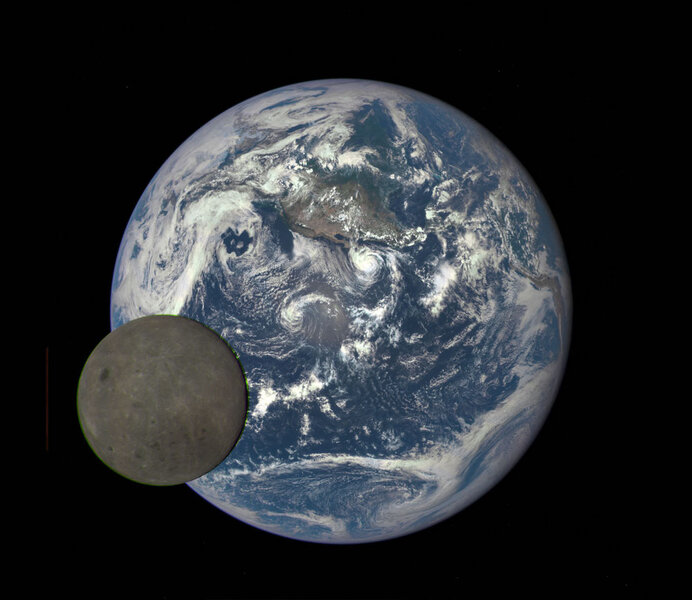Create a free profile to get unlimited access to exclusive videos, sweepstakes, and more!
The newly formed Moon may have tidally heated the Earth
The Moon was so close it would've loomed huge in the sky.

Sometimes the rising Moon looks huge over the horizon, big enough that you could almost fall into it. That's an illusion, though. Your brain is tricking you into thinking it's bigger than it really is.
But, if you had seen the rising Moon, oh, say, 4.4 billion years ago, it would've been immense on the horizon. Shortly after it formed it was much, much closer to Earth, and would have appeared 15 times bigger in the sky than it does now.
This, it turns out, may also help solve a long-standing and pernicious astronomical problem: Why wasn't the Earth frozen solid when it was young?
When the Earth was very young, a few million years after it first formed, it was very hot. Certainly after a Mars-sized planet whacked us but good and formed the Moon, the Earth was heated substantially again. But after that it would've cooled.
The thing is, stars like the Sun get hotter with age. Around the time the Moon formed, roughly 70 million years after Earth did, the Sun was only about 70% as luminous as it is today, getting warmer and brighter by roughly 6% every billion years. That means Earth wasn't receiving nearly as much heat then as it is now. The surface should've been frozen.
But we see lots of evidence of liquid water from back then; minerals and rock formations that indicate they were submerged when they formed. Somehow, Earth's temperature remained somewhat stable over the eons despite the Sun getting hotter. This is called the Faint Young Sun Paradox.
There must have been some other source — or more likely, sources plural — of heat to keep the Earth clement. Some ideas put forth are excessive greenhouse gases in the atmosphere; a more massive young Sun which would've made it hotter back then, with the mass lost through a more powerful solar wind; radioactive elements inside the Earth adding heat; and more. It's not at all clear what that source may have been, though.
In a new paper, a team of scientists proposes a significant source of heating may have been the Moon.
The Moon heats the Earth even today, though only a wee bit, through tides. The two interact gravitationally in weird and subtle ways — I've written a fairly thorough explanation of it — but in a nutshell the gravity of the Moon stretches the Earth, causing the tides. As the Earth rotates the tidal bulges generate internal heat through friction, warming the planet's interior, which makes its way out to the surface. Some effects of this are that it slows the Earth's rotation, and the Moon recedes from the Earth by about 4 centimeters per year; roughly the same speed your fingernails grow.
This tidal effect is enormously dependent on distance. The strength weakens with the cube of the Moon's distance, so double the Moon's distance and the tidal force drops by a factor of 2 x 2 x 2 = 8 times.
Right after it formed, the Moon may have been as close to the Earth as 24,000 kilometers. That's ~15 times closer than its current distance of about 380,000 km. This means that right after it formed the tidal effects would've been staggering, well over 3,000 times what they are now.
Think on that: The current ocean tides are currently* about 0.6 meters in height on average. But back then they would've been 3,000 time higher or nearly 2 kilometers. In some places they would've been much higher, too, depending on the shapes of continents at the time. The surface of the Earth would've been an apocalyptic mess, given our day was only a couple of hours long back then, meaning there would've been these enormous tides sweeping over the planet once every hour or so! Yikes.
Most models of tidal heating show the Moon's contribution to Earth's warmth was small even shortly after it formed. However, the authors of the new work claim these models are oversimplified — in the models' defense this calculation is extremely difficult and filled with unknown factors. Still, they decided to do a more detailed analysis of tidal heating than has been done before.
In general this calculation is hard to do for a lot of reasons; it depends on Earth's interior structure, how efficiently the tidal force from the Moon worked on the Earth, how it changed over time, and more. The authors looked into these factors and created a simple ad-hoc model of how this mechanism behaved; they made some assumptions that may or may not be right, but are at least plausible, so that the calculations can be done. In the end they're not trying to prove the Moon in fact heated the Earth enough to solve the faint young Sun paradox, but instead want to show that the idea of lunar heating at least isn't silly.
Also, they used a range of numbers in their model to see which ones match the amount of energy the Moon could've dumped into the Earth's interior — for example, the timescale over which the tidal force weakens; if it's short it dumps a lot of energy quickly into the Earth, but if it weakens more slowly it take longer to add energy.
What they found is that even their most extreme models of tidal heating are small compared to the amount of sunlight absorbed by the Earths surface. But this isn't necessarily a failure. Even a modest amount of tidal energy added could cause geological processes like volcanism to go into overdrive. This happens on Jupiter's moon Io, which has significant tidal heating from Jupiter and is the most volcanically active object in the solar system. Some of the lunar tidal heating models give Earth about the same amount of energy, so it's possible this could've triggered volcanism, releasing greenhouse gases and heat from Earth's interior, which would've aided in warming the planet's surface billions of years ago.
What they find is that at best tidal heating doesn't solve the paradox, but it could still have been a significant contributor to Earth's surface warming. This isn't proof by any means, but more of a call to action for scientists to keep this in mind and look into it more deeply.
I'm OK with that, and even support it. This sort of physics is really hard and fraught with roadblocks. You have to make some assumptions in the math to be able to come to any conclusions at all. So while this idea of more tidal heating from the Moon than previously thought may not be right, it also may not be wrong. It's plausible, and that alone is enough reason to keep looking into it.
*"Current"ly! Haha! Ha!



























